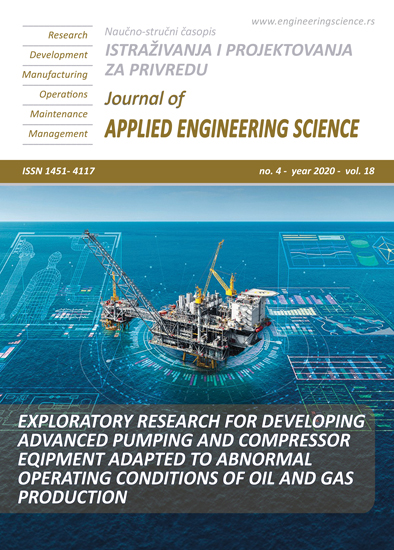CALCULATION OF THE MULTI-BLADE ROTARY-FRICTION TOOL’S CUTTING CUPPED CUTTER TO STRENGTH IN THE ANSYS WB SURROUNDING
Abstract
The authors developed the design of a special multi-blade rotary-friction tool. The multi-blade rotary-friction tool is equipped with two cupped cutters – heating and cutting. The heating cupped cutter is made of medium-carbon structural steel of any brand, and the cutting cupped cutter is made of steel R6M5. The final formation of the treated surface and its quality is provided by the cutting cupped cutter. This article presents the results of the calculation of the strength of the cutting cupped cutter multi-blade rotary friction tool. As a result, the following were established: when processing steels 30HGSA cutting force components reach the maximum value than when processing materials 40HN2MA, St.45, and St.3c (calm); strength and rigidity of the cutting cupped cutter is sufficient for processing optimal cutting conditions: nsp = 1000 rpm; S = 0.42 mm / rot; t = 1.0 mm.
References
Rakishev, A. K.. (2017). Research and development of the combined method of rotary-friction turning. KSTU, Karaganda.
Sherov, K.T., Sikhimbayev, M.R., Donenbayev, B.S., Ainabekova, S. (2017). Experimental research of rotational-and-frictional boring of big holes in large parts. Journal of Theoretical and Applied Mechanics, vol. 47, no. 4, p. 23-36, DOI: 10.1515/jtam-2017-0018.
Hackenschmidt, R., Alber-Laukant, B., Rieg, F. (2010). Rational milling of metals. Russian Engineering Research, vol. 35, no. 1, p. 43-45, DOI: 10.3103/s1068798x1501013x.
Demyanushko, I. V., Birger, I. A. (1988). Strength calculation of rotating disks. Mashinostroenie, Moscow
Sherov, K.T., Sikhimbayev, M.R., Mazdubay, A.V., Musaev, M.M. (2017). The research of the temperature impact in tool - metal blank contact on the quality of the cut at thermo-frictional cutting. Mechanics and Mechanical Engineering, vol. 21, no. 3, p. 755-762, DOI:10.5545/sv-jme.2011.013.
Jerusalemsky, D. E. (1970). Study of metal cutting tools with rotating cuppeds: abstract. ... cand.tech. sciences. - Tula. - P. 46.
Derganov, B. S. (1970). Investigation of the process of cutting roller rotating cutters: abstract. ... cand.tech. sciences. - M. - p. 23.
Popov, M. Yu. (2012). Special rotary cutting tool. Bulletin of SUSU, vol. 20, no. 33, p. 154-156.
Konovalov, E. G., Sidorenko, V. A., Sous, A.V. (1982). Modeling of cutting processes by finite element method. Science and technology, Minsk. - 272p.
Krivoruchko, D. V., Zaloga, V. A. (2012). Progressive schemes of rotary cutting of metals. University book, Sumy. - 496 p.
Sherov, K.T., Sikhimbayev, M.R., Sherov, A.K., Mazdubay, A.V., Rakishev, A.K. (2017). Matematical modeling of thermofrictional milling process using ANSYS WB software. Journal of Theoretical and Applied Mechanics, vol. 47, no. 2, p. 24-33, DOI: 10.1515/jtam-2017-0008.
Nasad, T.G., Sherov, K.T., Absadykov, B.N., Tusupova, S.O., Sagitov, A.A., Abdugaliyeva, G.B, Okimbayeva, A.E. (2019). Formation management in parts processing regenerated by surfacing. News of the National Academy of Sciences of the Republic of Kazakhstan, vol. 3, no. 435, p. 102-108, DOI: 10.32014/2019.2518-170x.74.
Donenbaev, B.S., Sherov, K.T. (2018). Finite element study and optimization of geometric parameters of parts of rotary friction tool. Mechanics and technologies, vol. 59, no. 1, p. 7-16.
Sherov, K.T., Sikhimbaev, M.R., Sharov, A.K., Musaev, M.M., Donenbaev, B.S. (2016). Mathematical modeling of the temperature field in thermal friction processing. Proceedings of the University, vol. 62, no. 1, p. 27-33.

